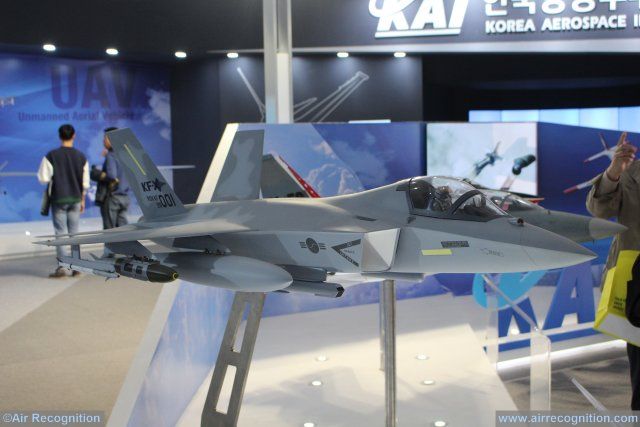Breaking news
ADEX 2017: Hanwha Systems details KF-X fighter jet avionics.
| 2017
| a | |||
|
|
|||
|
ADEX 2017
Seoul International Aerospace & Defense Exhibition 17 - 22 October 2017 Seoul Airbase - Republic of Korea |
|||
|
|
|||
|
ADEX 2017: Hanwha Systems details KF-X fighter jet avionics
|
|||
|
By Nathan Gain
Republic of Korea's KF-X fighter jet program was certainly the hottest topic of ADEX aerospace and defense exhibition, held last week at Seoul Air Base. A Korean defense electronics company, Hanwha Systems has a significant part in the KF-X development program, and is notably in charge of developing major components for the future fighter jet's avionics. |
|||
|
|
|||
 Hanwha Systems future EO TGP targeting pod Hanwha Systems future EO TGP targeting pod |
|||
|
|
|||
|
In 2016, the Korean Defense Acquisition Program Administration (DAPA) said South Korea will domestically develop some 90 items necessary for the KF-X program, including the active electronically scanned array (AESA) radar, and Electronic Optics Targeting Pod (EO TGP), which the U.S. government earlier refused to hand over to Korea for security reasons.
According to Hanwha Systems' R&D Center representative, the company is currently working on at least six systems which will compose the backbone of the RoKAF KF-X jets: the AESA radar; EO TGP; Mission Computer; Infrared Search & Track System (IRST); Multi-Function Display (MFD); and an Audio Communication Control System (ACCS). The KF-X future EO TGP targeting pod is currently being developed by Hanwha Systems to provide the aircraft with Air and Land targeting capabilities. Besides looking similar to Lockeed Martin's Sniper Advanced Targeting Pod, "the EO TGP will have similar functions," said the representative. Hanwha EO TGP key features will include high-power laser irradiation and precision weapons guidance, precise line of sight stabilization using small gimbal, and target information linked to armament system. The EO TGP will be tested starting 2020 from a commercial flying testbed aircraft, which has not yet been picked by Hanwha. First batch of EO TGP will be delivered with the first production KF-Xs, in 2025-2026. |
|||
|
|
|||
 Leonardo' SkyWard IRST showcased on Hanwha Systems booth at ADEX 2017 Leonardo' SkyWard IRST showcased on Hanwha Systems booth at ADEX 2017 |
|||
|
|
|||
|
But Hanwha Systems' work is not limited to targeting pod. The company is also jointly developing a new Infrared Search and Track (IRST) system based on Selex ES, a Leonardo subsidiary, SkyWard-G system.
According to Leonardo, the SkyWard-G IRST is a long-range electro-optical sensor. It is a passive system that does not emit any signals of its own when in use. It detects the heat signatures of other airborne systems but cannot be detected in return. It comprises two Line Replaceable Units (LRU) - a Sensor Head Unit (SHU) and a Processor Unit (PU), the later being developed and provided by Hanwha. This future IRST "will be able to enhance the aircraft low-detection capability by limiting radio wave emission," said Hanwha's representative. The KF-X will also receive an indigenous Multi-Function Display (MFD) system like the 8"x20" MFDS installed in Lockheed's F-35 Lightning II fighter jet. This next-generation smart multi-function display will be applicable to up-to-date fighter jets and helicopters, such as the future Light Armed Helicopter being developed by Korea Aerospace Industries (KAI). It will display high-speed and capacity video (ARINC-818) from the Mission Computer and tranfer pilot's input signal to MC. The MFD will be mounted on both forward and after seat of the two-seat version confirmed by the developers in July 2017. KF-X's future MFD will have a 2560x1280 resolution and feature high sensivity touch interface. South Korea launched the KF-X project in 2015 with the aim of producing more than 120 cutting-edge fighters to replace its aging jet fleet of F-4s and F-5s. It plans to pour a total of 18 trillion won (US$16 bn) into the project by 2026, with the production of six prototype jets scheduled to begin in July next year. |
|||
|
|
|||
 |
|||



















